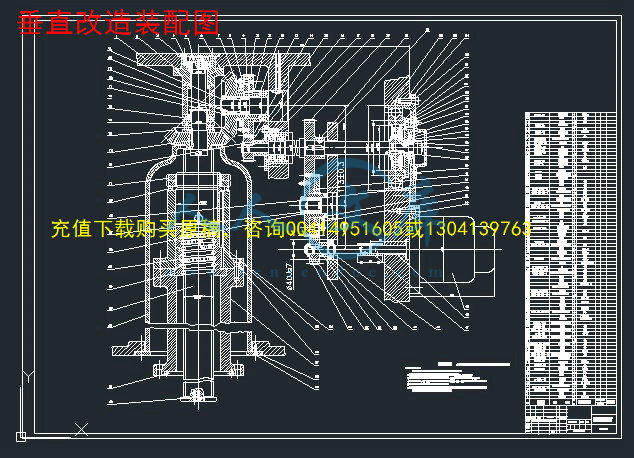摘要
本论文在本专业社会实践的基础上,结合实际所要加工零件的精度、生产率、批量、材质,所选用的数控加工系统,以及其它各方面因素的综合论证拟定改造方案,对万能铣床进行垂直方向的改造,以达到使该型号铣床能够最优化的适应实际零件的加工,最大限度满足所要加工零件的要求。因此,通过查阅大量的工具书,有关标准,了解并熟知该型机床与改造方案有关的详细数据,在此基础之上选定合理的改造数据,比如:丝杠的转速、传动比、滚珠丝杠副的刚度、轴向载荷等。结合实际改造的需要对各数据进行最优化合理配比,最终达到顺利完成对该机床的改造。
关键词:伺服驱动 切削力 滚珠丝杠副 传动比 载荷
Abstract
The paper in the profession on the basis of social practice, combined with the actual processing of parts to the accuracy, productivity, volume, material, the use of CNC machining systems, and other factors demonstrate the development of a comprehensive rehabilitation programs, the direction of universal vertical milling machine the transformation in order to achieve so that the type milling machine can be optimized to adapt to the actual parts machining, machining parts to be possible to meet the requirements. Therefore, by access to a large number of books, and related standards, understanding and kind, well-known bed and the transformation of detailed data relating to the program, on this basis, a reasonable selection of the transformation of data, such as: screw rotation speed, transmission ratio, ball wire Vice-bar stiffness, axial load and so on. Light of the actual transformation of the data need to optimize all reasonable proportion, and ultimately achieving the successful completion of the transformation of the machine.
Keywords: Servo-driven Cutting force Ball screw Transmission ratio Load
目录
绪论- 1 -
第一章 毕业设计任务书- 3 -
一、毕业设计的目的- 3 -
二、毕业设计的课题- 3 -
1、卧式升降台铣床的数控改造- 3 -
(1)、拟定方案- 3 -
(2)、设计内容- 3 -
2、设计时间安排- 3 -
第二章 数据准备- 4 -
一、机床数据- 4 -
二、工艺数据- 4 -
第三章 总体改造方案- 5 -
一、伺服驱动- 5 -
二、数控装置- 6 -
三、其它电气装置- 7 -
四、机械部分- 7 -
第四章 步进电机和滚珠丝杠的选取计算- 7 -
一、切削力的计算- 7 -
二、丝杠工作时轴向压力F轴的计算- 9 -
三、滚珠丝杠副工作负荷的计算- 9 -
1、丝杠的转速- 9 -
2、丝杠寿命系数L- 13 -
3、丝杠工作动载荷C- 13 -
(1)滚珠丝杠副轴向刚度Kz的计算- 14 -
丝杠的轴向刚度Ksz- 14 -
螺母组件的轴向刚度Klz- 15 -
支撑轴承的轴向刚度Kcz- 15 -
(2)滚珠丝杠副临界转速的验算- 16 -
第五章 关于滚珠丝杠副的性能分析- 17 -
第六章 双片齿轮错齿法调隙机构- 18 -
第七章 部分数控系统控制软件的框图- 20 -
第八章 凸轮加工程序- 21 -
数字控制的发展- 24 -
The Development of numerical control- 27 -
设计体会- 32 -
致谢- 33 -
参考文献- 34 -
附录- 34 -
绪论
机床是在人类认识和改造自然的过程中产生,又随着社会生产的发展和科学技术的进步而不断发展、不断完善的。最原始的机床是木制的,所有运动都是由人力或畜力驱动,主要用于加工木料、石料和陶瓷制品的泥坯,它们实际上并不是一种完整的机器。现代意义上的用于加工金属零件的机床,是在18世纪中叶才开始发展起来的。
18世纪发明了机动刀架,并以蒸汽机为动力,对机床进行驱动或通过天轴对机床进行集体驱动,才初步形成了现代机床的雏形。19世纪至20世纪初,随着电动机的问世,电动机取代了蒸汽机,经过了由天轴对机床进行集体驱动、单独电动机驱动的封闭齿轮箱结构的发展过程,才使机床基本具备了现代的结构形式。20世纪初到20世纪40年代,随着高速钢和硬质合金刀具的使用以及液压等技术的应用,机床在传动、结构、控制等方面得到很大的改进,加工精度和生产率得到显著提高。自20世纪50年代以来,计算机技术开始应用于机床中,先后出现了数控机床、加工中心、柔性制造系统等。计算机集成制造的出现,表明机械制造业正在走向一个崭新的变革时代。电火花加工、电解加工、超声波加工、激光加工、电子束加工、磨料流加工、磨料喷射加工等各种机械加工设备,表明特种加工设备也有了长足的发展。




 川公网安备: 51019002004831号
川公网安备: 51019002004831号